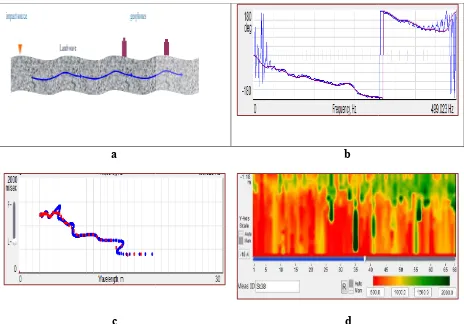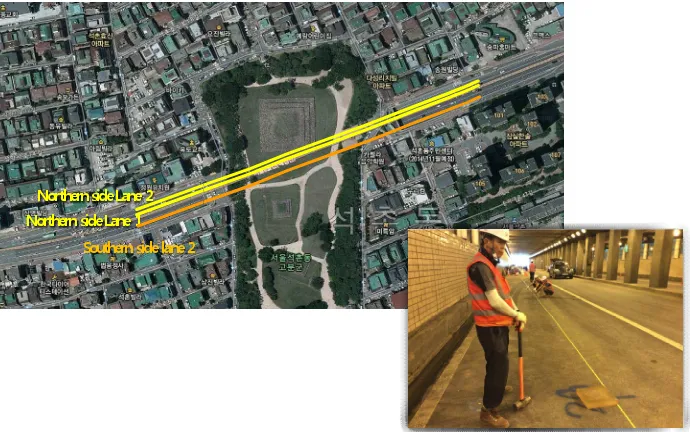DETECTION OF CAVITY UNDER A CONCRETE BOX TUNNEL
BY NONDESTRUCTIVE FRACTAL TEST
Sri Atmaja P.Rosyidi *1 Anita Rahmawati.*2, Joh, S.H.ᵻ2, Nayan, K.A.M.3
1Department of Civil Engineering, Universitas Muhammadiyah Yogyakarta, Indonesia 2Department of Civil and Environmental Engineering, Chung-Ang University, Korea
3Department of Civil and Structural Engineering, Universiti Kebangsaan Malaysia, Bangi,
Malaysia
ABSTRACT
An innovative, quick and accurate investigation techniques for detecting cavity under pavement concrete slab becomes significant in order to avoid the concrete slab pavement problems during its service-life. Problems of concrete pavement can be due to two basic causes, i.e, deterioration or deficiency of the pavement, e.g., cracks; and the structural adequacy of the pavement and base structure e.g. cavities in concrete slab and deflection causing settlement. In this research, an improved technique for detecting cavity under concrete box tunnel based on nondestructive Flexural-Rigidity Assessment Technique of Concrete Tracks by Anti-symmetric Lamb Waves (FRACTAL) was proposed. The research was carried out at an concrete box tunnel in Seoul. An appropriate non-destructive technique for investigating at the pavement under concrete box tunnel on the existing pavement should meet the requirement of speed and reliability in field testing. Therefore, flexural rigidity was chosen as a key parameter to assess the structural integrity of a concrete box tunnel, rather than material stiffness. The testing results indicate that the FRACTAL technique is able to detect cavities under the concrete box tunnel.
I. INTRODUCTION
the deteriorated state of the pavement under concrete box tunnel in order to early-evaluation of cavities.
Cavity under concrete box tunnel pavement slab is the emergence of cavity between the face slab and the base, which is structural destruction of road pavement. The emergence of cavity is detrimental to the forces of slab, especially to the edge ad corner of slab. The forced state of slab is similar with cantilever, which may lead to excessive stress and strain and is easy to damages like fracture and crushing. It will seriously affect the service performance and fatigue life of pavement slab.
In recent years, cavities under concrete box tunnel have been found in some road in South of Korea. Five large underground hollows were discovered underneath one of Seoul’s road tunnels (http://koreaherald.com).The newly found cavities are large enough to contain stacks of cars. They are located only a few meters away from two similar cavities discovered earlier on August 2014 below the Seokchon tunnel roadway in eastern Seoul.
A quick and efficient of the Flexure Rigidity Assessment Technique of Concrete Tracks by Anti-symmetric Lamb Waves (FRACTAL) is proposed from this study to measure non-destructively the stiffness of concrete pavement. This paper attempts to identify the cavity under concrete box tunnel using NDT Fractal Technique.
II. FRACTAL TECHNIQUE
Figure 1. 2-D representation of phase velocity of Lamb wave
Figure 1 shows the agreement between the fundamental modes of Rayleigh waves and Lamb waves at frequency 0 – 3000Hz. Lamb wave can be determined by even surface-waves test. The difference between two modes is attributed to the subgrade stiffness considered in Rayleigh wave method. The frequency below discontinuity 2.993 Hz (A and B) is Lamb wave.
III. INVESTIGATION OF CAVITY UNDER CONCRETE PAVEMENT
3.1.Analysis Data of Fractal Test
Fractal Rigidity Assessment Technique of Concrete Tracks by Anti-symmetric Lamb Waves (FRACTAL) can be used to evaluate the stiffness of concrete slabs resting on subgrade. Cho et al. (3) originally developed the FRACTAL technique. They used the FRACTAL technique to assess the potential deflection of concrete tracks by measuring the flexural rigidity of concrete railroad tracks.
between 3m and 8 m finds a Lamb
FRACTAL tests. c. Wave length for Lamb wave measured by FRACTAL tests representation of Lamb wave velocities measured by FRA
3.2. Set Criteria for FRACTAL Test Data Interpretation The results from data analysis of the tests performed illustrated in Figure 3a and
wavelength between 4m to
concrete box tunnel were found with be detected with velocity of 1
wave velocity were found to be no cavity under concrete box
a Lamb-wave velocity between 1000 to 1500 m/sec. produces Lamb-wave velocities less than 1000 m/sec.
b
d
Rigidity Assessment Technique of Concrete Tracks by Anti . b. Phase difference spectra for Lamb wave measured by c. Wave length for Lamb wave measured by FRACTAL tests representation of Lamb wave velocities measured by FRACTAL
Set Criteria for FRACTAL Test Data Interpretation
data analysis of the tests performed under concrete box and 3b. The criterion of Lamb wave velocity was wavelength between 4m to 18 m. From Figure 3b, it was found that the
were found with the P wave velocity of 1,756 m/sec and 1,020 m/sec. On the other hand, Figure 3 shows were found to be 3,790m/sec and 2,166 m/sec, respectively. under concrete box tunnel.
between 1000 to 1500 m/sec. Whereas, for
Assessment Technique of Concrete Tracks by Anti-b. Phase difference spectra for Lamb wave measured by c. Wave length for Lamb wave measured by FRACTAL tests. d. 2-D
Northern side Lane 2 Northern side Lane 1
Southern side lane 2 a
Figure 3 a. The result of FRACTAL test without cavity The result of FRACTAL test with cavity
3.3. Application of fractal under concrete box FRACTAL test was performed in the
The location of the test can be seen in Figure 5.
Figure
The test was conducted in Northern side lane 1(UR
NE2: 0 ~ 136 m, UR-NW2: 0 ~ 28 m, 44 ~ 72 m, 85 ~ 254 m SW2A: 0 ~ 132 m, UR-SW2B: 0 ~ 218 m, and UR
out with 2m geophones interval and
concrete road and a measurement array is overlapped with an adjacent array by 2 m.
b
Figure 3 a. The result of FRACTAL test without cavity under concrete box tunnel. b. The result of FRACTAL test with cavity under concrete box tunnel
under concrete box tunnel in Seoul
FRACTAL test was performed in the road-pavement under concrete box The location of the test can be seen in Figure 5.
Figure 4. Location of FRACTAL test
in Northern side lane 1(UR-NW1: 0 ~ 328 m,), Northern side lane 2(UR NW2: 0 ~ 28 m, 44 ~ 72 m, 85 ~ 254 m) and Southern side lane 2
SW2B: 0 ~ 218 m, and UR-SE: 0 ~ 218 m). FRACTAL tests
out with 2m geophones interval and performed continuously along the longitudinal axis of the concrete road and a measurement array is overlapped with an adjacent array by 2 m.
under concrete box tunnel. b. concrete box tunnel
under concrete box tunnel in Seoul.
), Northern side lane ) and Southern side lane
3.4. Fractal evaluation for the pavement
The Fractal results were presented Northern side lane 1, the section from 0 the Lamb waves velocity was found to be under concrete box tunnel have cavities side lane 2 with the interval between 0m waves velocity was found to be
occurred in under concrete box tunnel
72 m have Lamb waves velocity more than 1000 m/sec
box tunnel. The Figure 5c shows the Lamb waves velocity in Southern side lane 2. UR with section more than 115m shows the Lamb waves velocity less than 1
SW2B areas with interval 120m to 135m and 160m to 206m have the Lamb than 1,020m/sec. The potential of cavities are detected on those sections.
Figure 5a. 2-D representation of Lamb
pavement under concrete box tunnel in Seoul
presented in Figure 5. Figure 5a shows the Lamb-wave velocities at lane 1, the section from 0 – 328m with contour color of lime green to red
was found to be 1,020 m/sec and below. It indicates that the
cavities in pavement layer. In Figure 5b, the section at Northern side lane 2 with the interval between 0m – 136m and 85m – 254m also show
was found to be less than 1.020 m/sec. It also can be identified tunnel. On the other hand, the section between 0 72 m have Lamb waves velocity more than 1000 m/sec where there are no cavity
shows the Lamb waves velocity in Southern side lane 2. UR
shows the Lamb waves velocity less than 1,020 m/sec. Also, UR with interval 120m to 135m and 160m to 206m have the Lamb waves
The potential of cavities are detected on those sections.
D representation of Lamb-wave velocities at Northern side lane 1 Seoul
wave velocities at lime green to red which that the pavement . In Figure 5b, the section at Northern show that the Lamb identified that cavities . On the other hand, the section between 0 – 28m and 44 – no cavity under concrete shows the Lamb waves velocity in Southern side lane 2. UR-SE2 area 020 m/sec. Also,
UR-waves velocity less
Figure 5b. 2-D representation of Lamb
Figure 5c. 2-D representation of Lamb
D representation of Lamb-wave velocities at Northern side lane 2
D representation of Lamb-wave velocities at Southern side lane 2 wave velocities at Northern side lane 2
IV. CONCLUSIONS
In this paper, a practice for identifying cavity under concrete box tunnel was established.
This technique is based on the flexural rigidity of a concrete under path. The findings from this study are as follows:
1. The FRACTAL technique was found to be a non-destructively and potential technique used for identifying cavity in pavement concrete under path.
2. From the results of FRACTAL test at Northern side lane 1, lane 2 and Southern side lane 2 in pavement concrete under path in Seoul shows that the cavities was found with Lamb wave velocity less than 1,020 m/s. The Lamb wave velocity below1.020 m/s indicates that there is cavity inside of concrete under path.
REFERENCES
Bowen, B. R. (1992). Damage detection in concrete elements with surface wave measurements. Ph.D. Dissertation. Air Force Inst of Tech Wright-Patterson AFB, OH, P.207.
Cho, M.-R., Joh , S.-H. Lee, I. H. (2008). Development of a Nondestructive seismic technique for flexural rigidity of concrete track. Journal of KSCE, Vol.28 No.6D. pp. 905~913.
Cho, M.-R., Joh, S.-H., Kwon, S.-A. and Kang, T. H. (2007). Nondestructive in-place strength profiling of concrete pavements by resonance search technique. Presented at 86th Annual Meeting of the Transportation Research Board, Washington, D.C., Jan.
Joh, S. H., Lee, I. W., Hwang, S. J., and Kim, S. C. (2009). Evaluation of concrete-track deformation for high-speed railways by characteristic stiffness. Presented at National conference of Korean Society for Railway. Joh, S.H., Hwang, S.K., Kang T. H., Park, S.C., Lee, I. W.(2010). Nondestructive identification of freezing-induced
cracks in concrete sleepers for high speed railway in Korea. Transportation Research Board, Washington, D.C.
Suk, C.H., (2014). Ruling party ministries to draft sinkhole measures. Korean Herald News Published : 2014-08-21 (http://koreaherald.com/view.php?ud=20140821000866)
Sansalone, M. and Streett, W. B.(1997). Impact Echo: Nondestructive evaluation of concrete and masonry. Bullbrier Press, Ithaca, N. Y., p. 339.


